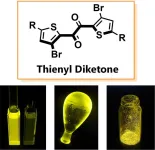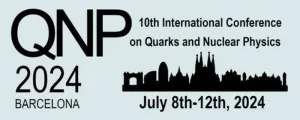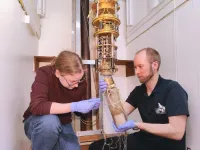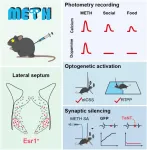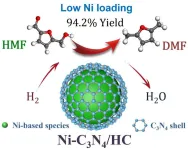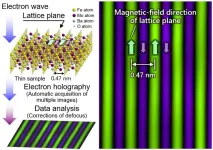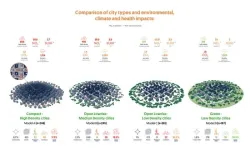(Press-News.org) Pancreatic cancer is a particularly aggressive and difficult-to-treat cancer, in part because it is often resistant to chemotherapy. Now, researchers at Stanford have revealed that this resistance is related to both the physical stiffness of the tissue around the cancerous cells and the chemical makeup of that tissue. Their work, published on July 4 in Nature Materials, shows that this resistance can be reversed and reveals potential targets for new pancreatic cancer treatments.
“We found that stiffer tissue can cause pancreatic cancer cells to become resistant to chemotherapy, while softer tissue made the cancer cells more responsive to chemotherapy,” said Sarah Heilshorn, a professor of materials science and engineering at Stanford and senior author on the paper. “These results suggest an exciting new direction for future drug development to help overcome chemoresistance, which is a major clinical challenge in pancreatic cancer.”
The power of the matrix
The researchers focused their efforts on pancreatic ductal adenocarcinoma, a cancer that starts in the cells lining the ducts of the pancreas and accounts for 90% of pancreatic cancer cases. In these cancers, the network of materials between the cells, known as the extracellular matrix, becomes notably stiffer. Scientists have theorized that this stiff material acts as a physical block, stopping chemotherapy drugs from reaching cancerous cells, but treatments based on this idea have not been effective in humans.
Heilshorn worked with PhD student Bauer LeSavage, lead author on the paper, to develop a new system to study these changes to the extracellular matrix and better understand their impact on pancreatic cancer cells. They designed three-dimensional materials that mimicked the biochemical and mechanical properties of both pancreatic tumors and healthy pancreas tissues, and used them to culture cells from pancreatic cancer patients, which they received from Calvin Kuo, the Maureen Lyles D’Ambrogio Professor at Stanford Medicine.
“We created a designer matrix that would allow us to test the idea that these cancerous cells might be responding to the chemical signals and mechanical properties in the matrix around them,” Heilshorn said.
Using their new system, the researchers selectively activated certain types of receptors in the cancerous cells and adjusted the chemical and physical properties of their designer matrix. They found that pancreatic cancer needed two things to become resistant to chemotherapy: a physically stiff extracellular matrix and high amounts of hyaluronic acid – a polymer that helps stiffen the extracellular matrix and interacts with cells through a receptor called CD44.
Initially, the pancreatic cancer cells in a stiff matrix full of hyaluronic acid responded to chemotherapy. But after some time in these conditions, the cancerous cells became resistant to chemotherapy – they made proteins in the cell membrane that could quickly pump out chemotherapy drugs before they could take effect. The researchers found that they could reverse this development by moving the cells to a softer matrix (even if it was still high in hyaluronic acid) or blocking the CD44 receptor (even if the matrix was still stiff).
“We can revert the cells back to a state where they are sensitive to chemotherapy,” Heilshorn said. “This suggests that if we can disrupt the stiffness signaling that’s happening through the CD44 receptor, we could make patients’ pancreatic cancer treatable by normal chemotherapy.”
Steps toward treatments
The discovery that pancreatic cancer cells interact with the stiff matrix around them through CD44 receptors was a surprise, Heilshorn said. Other cancers can be affected by mechanical properties of the extracellular matrix, but these interactions typically work through a different class of receptors called integrins.
“We showed that pancreatic cancer cells weren’t really using integrin receptors at all in our materials,” Heilshorn said. “That’s important, because if you want to design a drug to resensitize patient cells to chemotherapy, you need to know which biological pathway to interfere with.”
Heilshorn and her colleagues are continuing to investigate the CD44 receptor and the chain of events that follows after it is activated in a cancerous cell. The more they can reveal about the biological mechanisms that lead to chemoresistance, the easier it will be for drug developers to find a way to disrupt the process.
The researchers are also working to improve their cell culture model, adding new types of cells to better mimic the environment around a tumor, and tweaking it to investigate other mechanical properties beyond stiffness. In addition to opening up new avenues for treating chemoresistance in pancreatic cancer, the researchers hope this work highlights the potential role of the extracellular matrix in cancer progression and the importance of using realistic models to find treatments.
“When we design chemotherapies, we should be testing our cultures in matrices that are relevant to a patient,” Heilshorn said. “Because it matters – the way cells respond to drugs depends on the matrix that’s around them.”
Additional Stanford co-authors of this research include Christina Curtis, the RZ Cao Professor at Stanford Medicine and professor of medicine, of genetics, and of biomedical data science; Paul Bollyky, professor of medicine (infectious diseases) and of microbiology and immunology in the School of Medicine; senior research scientist Gernot Kaber; research technician Kremena Karagyozova; postdoctoral researchers Carla Huerta-López, Aidan E. Gilchrist, Kasper Karlsson, Amber R. Smith, and Christopher M. Madl; and graduate students Bauer L. LeSavage, Daiyao Zhang, Brad A. Krajina, Katarina C. Klett, Michelle S. Huang, and Christopher Long.
Heilshorn is the director of the Geballe Laboratory for Advanced Materials; a member of Stanford Bio-X, the Stanford Cardiovascular Institute, the Wu Tsai Human Performance Alliance, and the Maternal & Child Health Research Institute (MCHRI); and a faculty fellow of Stanford Sarafan ChEM-H. Bollyky is also a member of Bio-X, the Cardiovascular Institute, MCHRI, and the Wu Tsai Neurosciences Institute. Curtis is also a member of Bio-X and the Stanford Cancer Institute. Kuo is a member of Bio-X, the Stanford Cardiovascular Institute, MCHRI, the Stanford Medicine Children’s Health Center for IBD and Celiac Disease, the Stanford Cancer Institute, and the Wu Tsai Neurosciences Institute.
This work was funded by the National Institutes of Health, Stand Up to Cancer and Cancer Research U.K., and the National Science Foundation.
END
Reversing chemotherapy resistance in pancreatic cancer
2024-07-04
ELSE PRESS RELEASES FROM THIS DATE:
New organic molecule shatters phosphorescence efficiency records and paves way for rare metal-free applications
2024-07-04
A research team led by Osaka University discovered that the new organic molecule thienyl diketone shows high-efficiency phosphorescence. It achieved phosphorescence that is more than ten times faster than traditional materials, allowing the team to elucidate this mechanism.
Osaka, Japan – Phosphorescence is a valuable optical function used in applications such as organic EL displays (OLEDs) and cancer diagnostics. Until now, achieving high-efficiency phosphorescence without using rare metals such as iridium and platinum has been a significant challenge. Phosphorescence, which occurs when a molecule transitions ...
International summit of experts in nuclear physics at the University of Barcelona
2024-07-04
More than two hundred international experts will take part in the 10th International Conference on Quarks and Nuclear Physics (QNP2024), a scientific summit organized by the UB Institute of Cosmos Sciences (ICCUB), which will be held in the Aula Magna of the Faculty of Biology at the University of Barcelona from 8 to 12 July. This meeting, hosted by the UB for the first time, will bring together world experts in the fields of nuclear physics and hadronic physics to discuss the latest advances in theory, experimentation and technology ...
Clever pupils don’t need to attend academically selective schools to thrive, study finds
2024-07-04
Findings published in a new peer-reviewed paper in the British Journal of Educational Studies challenges the idea that academically selective schools are necessary for clever pupils to achieve good outcomes.
Selective schools are government-funded schools that enrol only the highest performing students. Pupils take a standardized entrance exam, from which the best-scoring are enrolled.
Some argue that selective schools are necessary for bright pupils to reach their full academic potential. Selective schools can ...
Searching for dark matter with the coldest quantum detectors in the world
2024-07-04
One of the greatest mysteries of science could be one step closer to being solved.
Approximately 80% of the matter in the universe is dark, meaning that it cannot be seen. In fact, dark matter is passing through us constantly – possibly at a rate of trillions of particles per second.
We know it exists because we can see the effects of its gravity, but experiments to date have so far failed to detect it.
Taking advantage of the most advanced quantum technologies, scientists from Lancaster University, the University of Oxford, and Royal Holloway, ...
UNSW Sydney's Dr Vaishnavi Ananthanarayanan receives RMS Award for Life Sciences
2024-07-04
This accolade highlights her pioneering research in the use of a diverse array of advanced microscopy techniques to uncover fundamental biophysical processes.
Currently holding a prestigious EMBL (European Molecular Biology Laboratory) Australia Group Leader fellowship, Dr Ananthanarayanan leads one of the largest and most dynamic research group in the EMBL Australia Node in Single Molecule Science, based in the Department of Molecular Medicine in the School of Biomedical Sciences.
Her research, which focuses on motor proteins and cytoskeleton dynamics, has set new standards ...
Researchers unveils a critical role of the lateral septum in drug addiction
2024-07-04
Recently, a research team led by Dr. ZHU Yingjie from the Shenzhen Institute of Advanced Technology, Chinese Academy of Sciences has published a study in Neuron, the study presents a comprehensive transcriptional profile of the lateral septum (LS) at the single-cell level, elucidating the spatial distribution of its major neuronal types. The study shows that neurons expressing estrogen receptor 1 (LSEsr1), predominantly located in the ventral subregion of LS, play a crucial role in reward-seeking and methamphetamine (METH) addiction.
In 1954, psychologists Olds and Milner discovered the brain's reward system through intracranial ...
Efficient hydrogenolysis of 5-hydroxymethylfurfural over Ni-C3N4 catalysts
2024-07-04
Utilization of biomass as the basic feedstock for the production and chemicals and energy storage has been demonstrated to be an important alternative to achieve sustainable society, which has attracted increasing interests in both academic and industrial communities for decades. 5-hydroxymethylfurfural (HMF), one of the most important bio-based platform compounds, could serve as a bridge feedstock between biomass resources and chemicals. It is possible to synthesize a series of high-value added chemicals from HMF through hydrogenation, ...
Hitachi’s holography electron microscope attains unprecedented resolution
2024-07-04
Tokyo, Japan—A research team from Japan, including scientists from Hitachi, Ltd. (TSE 6501, Hitachi), Kyushu University, RIKEN, and HREM Research Inc. (HREM), has achieved a major breakthrough in the observation of magnetic fields at unimaginably small scales. In collaboration with National Institute of Advanced Industrial Science and Technology (AIST) and the National Institute for Materials Science (NIMS), the team used Hitachi’s atomic-resolution holography electron microscope—with a newly developed image acquisition technology and defocus correction algorithms—to visualize ...
An innovative test to diagnose chagas disease in newborns
2024-07-04
An innovative test that combines a DNA extraction system inspired by a modified 3D printer (PrintrLab) with loop-mediated isothermal molecular amplification (LAMP) could be used to detect T. cruzi infection -responsible for Chagas disease- in newborns. This is the conclusion of a proof-of-concept study conducted in the Bolivian Chaco, an endemic area for Chagas disease. The study was coordinated by the Barcelona Institute for Global Health (ISGlobal), a centre supported by "la Caixa" ...
Compact cities have lower carbon emissions, but poorer air quality, less green space and higher mortality rates
2024-07-04
What types of cities exist in Europe and which are more favourable in terms of human health, environmental quality and carbon footprint? To answer these questions, a study led by the Barcelona Institute for Global Health (ISGlobal), a centre supported by the "la Caixa" Foundation, has analysed 919 European cities. The research, published in The Lancet Planetary Health, identified four basic urban configurations on the continent: compact-high density cities, open lowrise-medium density cities, open lowrise-low density cities and green-low density cities. The results show that greener and less densely populated ...
